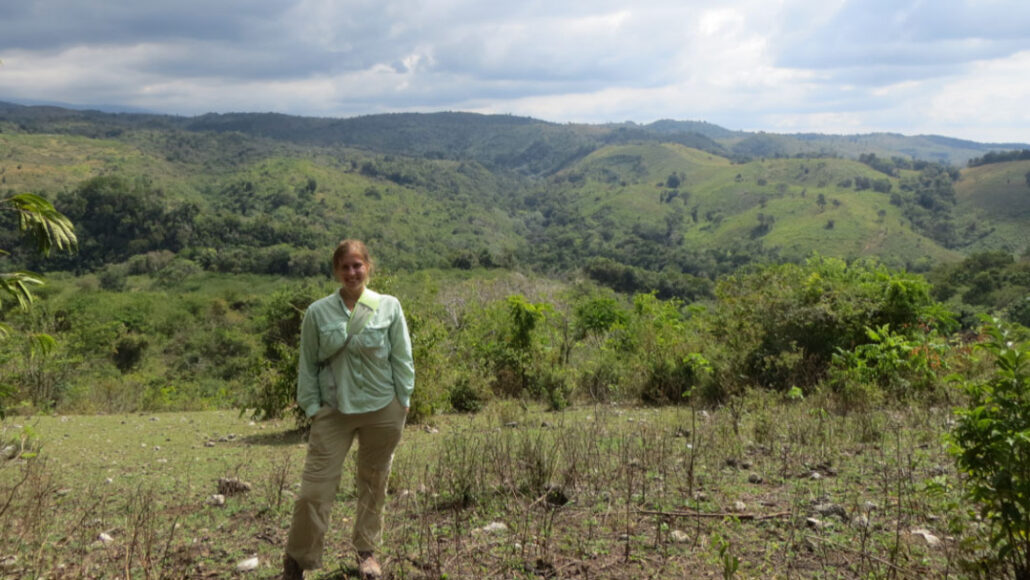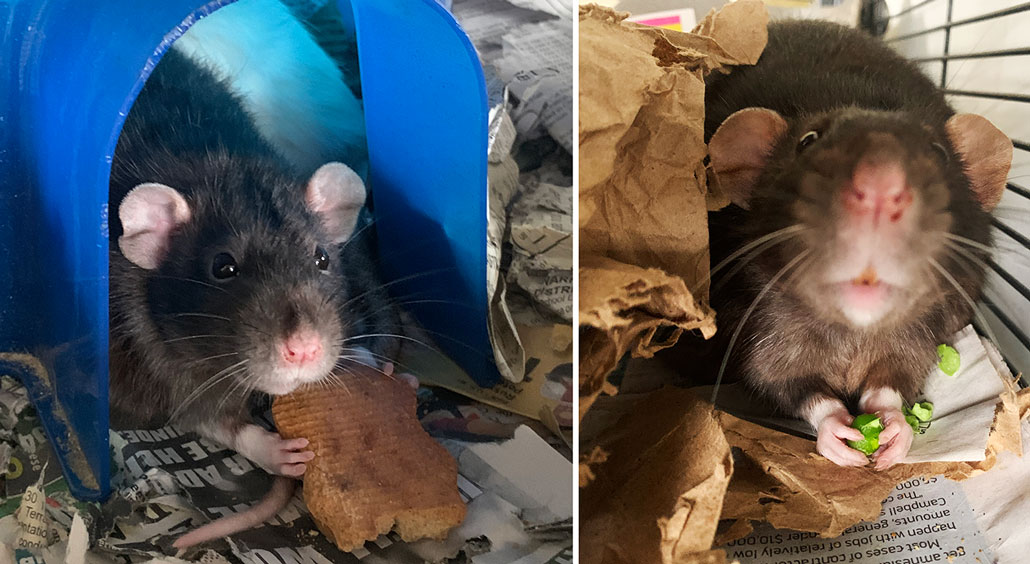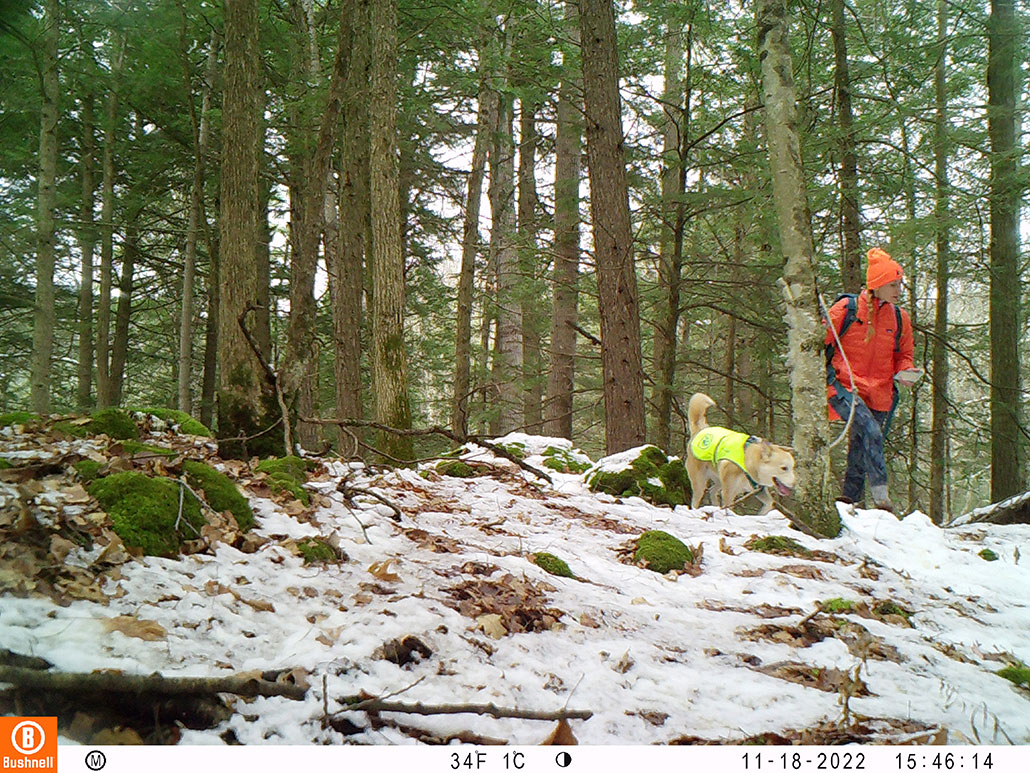A love of small mammals drives this scientist
Alexis Mychajliw looks to tar pits and fossilized poop to understand ancient ecosystems

Alexis Mychajliw loves studying small mammals, both alive and long deceased. But she gets some of her best ideas from her dog and other pets.
Courtesy of A. Mychajliw
Alexis Mychajliw credits her pet rats, hedgehog and dog for some of her best ideas. “They really inspire me,” says Mychajliw. “Just looking at their behaviors and asking questions like, ‘Why do they do these things?’ and ‘Do their wild relatives do these things?’”
Her pet rats’ droppings helped her recognize fossilized packrat feces, or coprolites, found in the La Brea Tar Pits of Los Angeles, Calif. In a 2020 study, Mychajliw used these 50,000-year-old coprolites to determine that Los Angeles was about 4 degrees Celsius (7.2 degrees Fahrenheit) cooler during the Pleistocene.
Her passion for mammals has led to research work all around the world. Mychajliw has studied urban foxes in Hokkaido, Japan, and the fossils of extinct ground sloths in Trinidad and Tobago. She now studies species extinctions and paleoecology, or ancient ecosystems, at Middlebury College in Vermont. She uses Pleistocene fossils trapped in tar pits some 50,000 years ago to better understand past environments. In this interview, she shares her experiences and advice with Science News Explores. (This interview has been edited for content and readability.)
What inspired you to pursue your career?
I honestly just love watching small mammals! In particular, I want to understand what they do and why. That’s taken me both in my own backyard and all around the world, trying to understand how different mammal species are responding to things like climate change and human activities. I’m trying to use my background as a scientist to understand how we can coexist with many of these mammals in the future. During my research, I started to realize that many of the species we care about have been impacted for hundreds, if not thousands, of years by human activities. And we really have to be looking at not just living things but also some recently dead things, too, to understand this fully.

How did you get to where you are today?
I studied ecology and evolutionary biology and also focused on conservation biology. I wanted to not just know the science, but also to know how it would affect people, policies and economics. I think it is really important to combine a science degree with other classes that let you see kind of the context of that science.
I was always driven by wanting to hang out with mammals. As an undergraduate student, I worked on these semi-aquatic rodents called muskrats out on some islands in the Gulf of Maine. I became fascinated by studying mammals on islands. I wanted to know how they got there and what they were doing on those islands. I was interested in how their ecology and genetics might be different because of evolving on an island system. Later, I worked at the La Brea Tar Pits in Los Angeles. I also lived in Japan for a bit, working on foxes there on the northern island of Hokkaido. I’ve had a lot of different training opportunities, but they all really focused on the same general question: How do we understand mammals as they interact with people and climate change over time?
How do you get your best ideas?
The best questions come from the people who live alongside these animals. To give you an example, when I started my graduate work, I wanted to work on solenodon conservation. Solenodons look like giant shrews. They’re venomous, and they’re pretty threatened by human activities. And there are only two species left. They represent nearly 70 million years of evolutionary history. So losing them would be a big blow to global conservation efforts and to protecting the mammal tree of life.
I really wanted to study how their venom evolved and look at ancient DNA. So I traveled to the Caribbean, where solenodons live. When I got there, I talked to local people who lived alongside this animal. What they wanted to know was what this animal ate. No one had ever studied that using molecular tools. And this was a problem because to conserve something, you need to know what resources it uses. But it was also a question of whether solenodons were conflicting with domestic chickens and roosters. Were they potentially eating these economically important animals for farmers? So I switched my research question to focus on solenodon diet.
What’s one of your biggest successes?
I love doing science that is meaningful to people. It’s not just about a publication. I like making people feel excited or appreciate something they never thought about. I loved the work I did figuring out what solenodons were eating. I could go back to people and give them an answer to a question they had — one that people hadn’t wanted to study before because it wasn’t a “big” scientific question. I also loved working on the packrat coprolites, or fossil feces, because again, it’s something that really captures people’s imagination.
What’s one of your biggest failures? And how did you get past that?
Plenty of things fail in the lab, right? You just get used to it. I don’t really think of these things as failures. So much of it is just redoing an experiment or approaching it through a different lens and trying again. We set up cameras to try and document different species and endangered species. Sometimes you don’t get any pictures on those cameras of the species you’re trying to find. It can be really challenging to figure out what we do with these hundreds of pictures of, let’s say, dogs, versus the solenodons we were actually trying to find. But we can always find a way to use data. So in that regard, you’re never really failing. You’re just figuring out something new that will ultimately help you get the data you want.

What do you do in your spare time?
I really love exploring new places. I do a lot of hiking with my dog. I love looking for mammals in the wild, so I do a lot of tracking. And I also enjoy looking for fossil sites. As someone who’s also trained as a paleontologist, I sometimes feel like I’m a fossil tourist. Even though I study vertebrate fossils from the Pleistocene, (meaning the oldest fossils I will work on are maybe 50,000 years old), there are fossils not too far from me in Vermont that are from the Ordovician. [The sites] were ancient oceans millions of years ago.
[Fossils can only be legally collected in certain places. If you aren’t in one of those places, don’t take the fossils. Just take photos of whatever you see.]
What piece of advice do you wish you had been given when you were younger?
There are a few. Certainly that it’s okay to fail. I think, especially now, we’re always trained with test scores and grades in mind. But I’ve realized that part of being a scientist is being 100 percent okay with things not working. Or doing something wrong the first time, because that’s the only way to learn. You really need to be a good critical thinker. And also, honestly, just being okay with the understanding that if this didn’t work, it’s not always my fault. It’s just how it goes in science!
Also, I let what I care about personally drive what I do professionally. People will frequently ask me why I study small mammals. And I tell them it’s because I like small mammals. I think they’re cute. I find them amazing. I’m not going to just say there’s this interesting ecological and evolutionary set of questions about them — which is also totally true! But I was inspired to work on them because I think they’re awesome. And that’s a perfectly great reason. If you’re going to spend your life working on something, you should probably think it’s awesome.
What would you recommend someone do if they’re interested in possibly pursuing a career in science?
Explore your interests and find something that you just can’t stop asking questions about. At the end of the day, being a scientist is knowing how to ask questions. Then you have to develop the right set of tools to get those answers.







